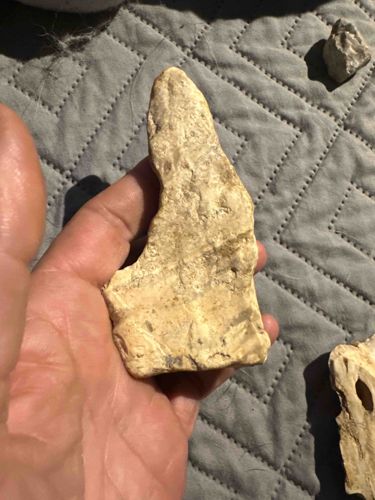
Light-Colored Chert or Flint Nodule
This appears to be a naturally occurring rock fragment, likely chert or flint, characterized by its irregular, somewhat elongated shape. The color is predominantly a light, creamy beige or off-white with subtle variations including very light brown or tan streaks and patches, possibly indicating different mineral concentrations or weathering patterns. The texture of the rock is rough and uneven, with numerous small indentations, ridges, and fractured surfaces, typical of cryptocrystalline quartz. One end tapers to a somewhat pointed or dulled apex, while the other end is broader and more irregularly fractured. The sides are not smooth, showing natural breaks and erosion. There are no discernible markings, deliberate carvings, or manufacturing details such such as maker's marks or signatures, suggesting it is an unmodified natural specimen. Its size is such that it comfortably fits within an adult hand, as depicted in the image. The condition appears to be natural, exhibiting no signs of recent damage, repairs, or artificial patina; any surface variations are consistent with natural geological processes over time. The material's inherent hardness and conchoidal fracturing properties are typical of chert or flint. Its appearance suggests a natural origin rather than an artifact modified by human activity, though it is difficult to completely rule out some degree of rudimentary shaping without closer inspection. The absence of polished or smoothed areas further supports its natural state.
AI-Generated Appraisal Disclaimer
Estimated Value
$5 - $15
Basic Information
Category
Geological Specimen
Appraised On
December 24, 2025
Estimated Value
$5 - $15
Item Description
This appears to be a naturally occurring rock fragment, likely chert or flint, characterized by its irregular, somewhat elongated shape. The color is predominantly a light, creamy beige or off-white with subtle variations including very light brown or tan streaks and patches, possibly indicating different mineral concentrations or weathering patterns. The texture of the rock is rough and uneven, with numerous small indentations, ridges, and fractured surfaces, typical of cryptocrystalline quartz. One end tapers to a somewhat pointed or dulled apex, while the other end is broader and more irregularly fractured. The sides are not smooth, showing natural breaks and erosion. There are no discernible markings, deliberate carvings, or manufacturing details such such as maker's marks or signatures, suggesting it is an unmodified natural specimen. Its size is such that it comfortably fits within an adult hand, as depicted in the image. The condition appears to be natural, exhibiting no signs of recent damage, repairs, or artificial patina; any surface variations are consistent with natural geological processes over time. The material's inherent hardness and conchoidal fracturing properties are typical of chert or flint. Its appearance suggests a natural origin rather than an artifact modified by human activity, though it is difficult to completely rule out some degree of rudimentary shaping without closer inspection. The absence of polished or smoothed areas further supports its natural state.
Related Tags
Get Your Items Appraised
Instant estimates of your treasures with AI-powered instant appraisals